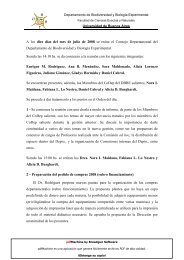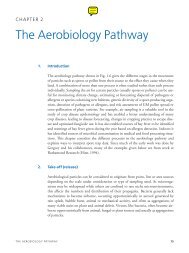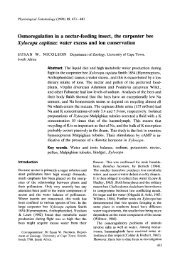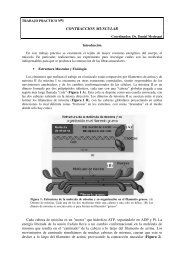Role of WUSCHEL in Regulating Stem Cell Fate in the Arabidopsis Shoot Meristem
Role of WUSCHEL in Regulating Stem Cell Fate in the Arabidopsis Shoot Meristem
Role of WUSCHEL in Regulating Stem Cell Fate in the Arabidopsis Shoot Meristem
Create successful ePaper yourself
Turn your PDF publications into a flip-book with our unique Google optimized e-Paper software.
<strong>Role</strong> <strong>of</strong> <strong>WUSCHEL</strong> <strong>in</strong> <strong>Shoot</strong> and Floral <strong>Meristem</strong>s<br />
811<br />
Figure 6. Model for <strong>the</strong> <strong>Role</strong> <strong>of</strong> WUS <strong>in</strong> <strong>the</strong> <strong>Shoot</strong> <strong>Meristem</strong><br />
WUS expression is conf<strong>in</strong>ed to a small group <strong>of</strong> cells (striped) <strong>in</strong><br />
<strong>the</strong> lower part <strong>of</strong> <strong>the</strong> central zone (CZ, black frame), underneath <strong>the</strong><br />
L1–L3 stem cells (sc, darkly shaded) and above <strong>the</strong> rib zone (RZ),<br />
a region <strong>of</strong> flat cells that will form <strong>the</strong> pith. WUS-express<strong>in</strong>g cells<br />
are required to specify <strong>the</strong> overly<strong>in</strong>g neighbors (arrow) as stem cells.<br />
l, leaf; p, leaf primordium; PZ, peripheral zone.<br />
a model <strong>in</strong> which WUS enables <strong>the</strong> cells express<strong>in</strong>g it<br />
to function as an organiz<strong>in</strong>g center that confers stem<br />
cell fate to its overly<strong>in</strong>g neighbors (Figure 6).<br />
This model suggests common mechanistic pr<strong>in</strong>ciples<br />
between shoot and root meristems. The root meristem<br />
conta<strong>in</strong>s a set <strong>of</strong> stem cells surround<strong>in</strong>g a small group<br />
<strong>of</strong> mitotically <strong>in</strong>active cells, <strong>the</strong> quiescent center. The<br />
results <strong>of</strong> ablation studies suggest that <strong>the</strong> cells <strong>of</strong> <strong>the</strong><br />
quiescent center <strong>in</strong>hibit differentiation <strong>of</strong> neighbor<strong>in</strong>g<br />
stem cells (van den Berg et al., 1997). Thus, although<br />
Figure 5. Expression <strong>of</strong> WUS mRNA <strong>in</strong> Postembryonic Development <strong>the</strong>re is ample evidence that shoot and root meristems<br />
(A) Seedl<strong>in</strong>g apex. A small group <strong>of</strong> cells <strong>in</strong> <strong>the</strong> center <strong>of</strong> <strong>the</strong> shoot employ different sets <strong>of</strong> regulatory genes, <strong>in</strong> both stem<br />
meristem, underneath <strong>the</strong> L3, expresses WUS. cells may be specified by a central organiz<strong>in</strong>g center.<br />
(B) Inflorescence. In <strong>the</strong> <strong>in</strong>florescence meristem (im), a small group <strong>of</strong><br />
Both meristems may <strong>the</strong>refore represent modifications<br />
central cells underneath <strong>the</strong> L3 expresses WUS. In floral meristems,<br />
<strong>of</strong> a basic meristem organization that function <strong>in</strong> differstages<br />
1 (1) and 3 (3), a small group <strong>of</strong> cells underneath <strong>the</strong> L2<br />
expresses WUS. Note that <strong>the</strong> expression doma<strong>in</strong> <strong>in</strong> floral meristems ent developmental contexts to give rise to <strong>the</strong> shoot<br />
is shifted one cell layer upward <strong>in</strong> comparison to vegetative shoot and <strong>the</strong> root, respectively. Our f<strong>in</strong>d<strong>in</strong>gs also suggest<br />
meristems (shown <strong>in</strong> [A]) and <strong>in</strong>florescence meristems. The black similar mechanisms <strong>of</strong> stem cell specification <strong>in</strong> plants<br />
l<strong>in</strong>e represents <strong>the</strong> plane <strong>of</strong> section shown <strong>in</strong> (C). and animals. For example, <strong>in</strong> C. elegans, <strong>the</strong> stem cells<br />
(C) Inflorescence. Cross section through an <strong>in</strong>florescence (im), a <strong>of</strong> <strong>the</strong> germl<strong>in</strong>e are ma<strong>in</strong>ta<strong>in</strong>ed by signal<strong>in</strong>g from a neighstage<br />
1 (1), and a stage 2 (2) floral meristem all show<strong>in</strong>g WUS expresbor<strong>in</strong>g<br />
somatic cell, <strong>the</strong> distal tip cell (Henderson et<br />
sion <strong>in</strong> <strong>the</strong> center.<br />
(D) Stage 2 flower. Strong WUS expression is detected <strong>in</strong> a cell<br />
al., 1994). Thus, <strong>in</strong>teractions between neighbor<strong>in</strong>g cells<br />
group below <strong>the</strong> L2.<br />
appear to be a common <strong>the</strong>me <strong>in</strong> how different organ-<br />
(E) Stage 6 flower. Sepals (s), petal (pt), and stamen (st) primordia isms specify <strong>the</strong> pluripotent state <strong>of</strong> stem cells. It reare<br />
visible. WUS expression seems to be reduced compared to ma<strong>in</strong>s to be determ<strong>in</strong>ed whe<strong>the</strong>r such cellular <strong>in</strong>teracearlier<br />
stages as shown <strong>in</strong> (D). tions rely on similar molecular mechanisms.<br />
(F) Stage 10 flower. Carpel primordia (ca) occupy <strong>the</strong> center <strong>of</strong> <strong>the</strong> The phenotypic defects <strong>of</strong> <strong>the</strong> respective mutants and<br />
flower. No WUS expression is detected.<br />
<strong>the</strong> expression patterns <strong>of</strong> <strong>the</strong> genes <strong>in</strong>dicate that WUS<br />
(G) Seedl<strong>in</strong>g apex. Sense control. No sta<strong>in</strong><strong>in</strong>g detected.<br />
(H) Stage 2 and 3 flowers. Sense control. No sta<strong>in</strong><strong>in</strong>g detected.<br />
and STM act at different regulatory levels <strong>in</strong> <strong>the</strong> shoot<br />
WUS mRNA is <strong>in</strong>dicated by dark brown. p, leaf primordium; pe, meristem. WUS is expressed <strong>in</strong> a small subset <strong>of</strong> meripedicel;<br />
cl, caul<strong>in</strong>e leaf; s, sepal. Scale bars, 30 �m.<br />
stem cells and specifically affects <strong>the</strong> fate <strong>of</strong> cells <strong>in</strong><br />
<strong>the</strong> meristem center. By contrast, STM is expressed<br />
throughout <strong>the</strong> meristem dome but is downregulated <strong>in</strong><br />
WUS Affects <strong>Stem</strong> <strong>Cell</strong> <strong>Fate</strong> <strong>in</strong> a <strong>the</strong> <strong>in</strong>cipient organ primordia (Long et al., 1996). To-<br />
Non–<strong>Cell</strong>-Autonomous Manner ge<strong>the</strong>r with its antagonist CLV1, it appears to regulate<br />
WUS expression def<strong>in</strong>es a novel functional doma<strong>in</strong> <strong>of</strong> <strong>the</strong> transition <strong>of</strong> cells toward differentiation and organ<br />
<strong>the</strong> shoot meristem that has not been previously recog- formation, with STM prevent<strong>in</strong>g premature organ formanized<br />
as a functional or morphological unit. WUS is ex- tion (Clark et al., 1996; Endrizzi et al., 1996). Thus, we<br />
pressed <strong>in</strong> a group <strong>of</strong> cells underneath <strong>the</strong> stem cells, suggest a model <strong>in</strong> which WUS is required to specify<br />
but not <strong>in</strong> <strong>the</strong> stem cells <strong>the</strong>mselves, which appear to stem cells, while STM activity allows <strong>the</strong>ir progeny to<br />
be misspecified <strong>in</strong> <strong>the</strong> wus mutant. This f<strong>in</strong>d<strong>in</strong>g suggests<br />
proliferate before be<strong>in</strong>g partitioned <strong>in</strong>to organ primordia.


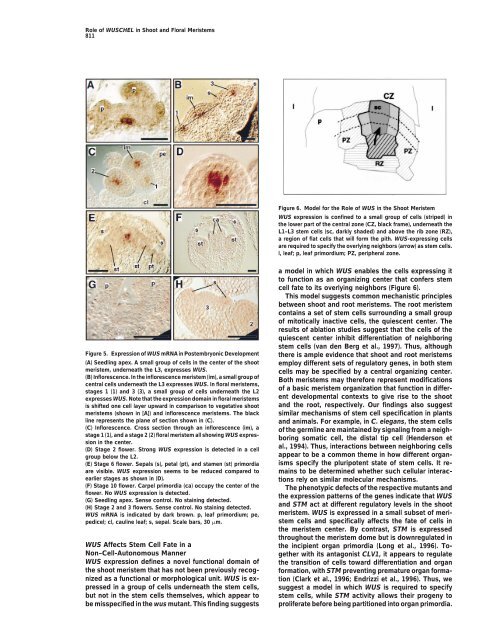
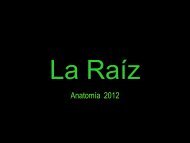
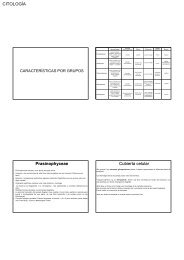


![Estructuras secretoras internas [4.64 MB]](https://img.yumpu.com/14294979/1/190x143/estructuras-secretoras-internas-464-mb.jpg?quality=85)
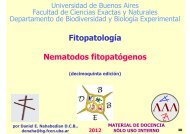
![anatomía y exomorfología [7.14 MB]](https://img.yumpu.com/12744163/1/190x143/anatomia-y-exomorfologia-714-mb.jpg?quality=85)
